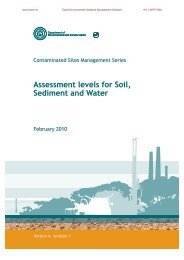EPA PUBLICATION 448 CLASSIFICATION OF WASTES - ESdat
EPA PUBLICATION 448 CLASSIFICATION OF WASTES - ESdat
EPA PUBLICATION 448 CLASSIFICATION OF WASTES - ESdat
You also want an ePaper? Increase the reach of your titles
YUMPU automatically turns print PDFs into web optimized ePapers that Google loves.
www.esdat.net Esdat Environmental Database Management Software +61 2 8875 7948<br />
<strong>EPA</strong> <strong>PUBLICATION</strong> <strong>448</strong> <strong>CLASSIFICATION</strong> <strong>OF</strong> <strong>WASTES</strong><br />
Management requirements<br />
Category C (Contaminated soil) and Category B<br />
(Contaminated soil) can be accepted at a landfill or<br />
facility licensed by <strong>EPA</strong> to accept such waste.<br />
Category A (Contaminated soil) will require treatment<br />
to reduce or control the hazard before meeting<br />
acceptance criteria for disposal at an appropriate <strong>EPA</strong>licensed<br />
facility.<br />
Generators of contaminated soils may wish to seek a<br />
new classification for <strong>EPA</strong> approval, where it can be<br />
demonstrated that a different category from that<br />
outlined above is appropriate for a particular<br />
contaminant or group of contaminants in soil. For<br />
example, a contaminant that is intrinsically<br />
immobilised may display a low hazard because of the<br />
very low leachable concentration, despite a relatively<br />
high total concentration. Applications will need to<br />
provide justification why the proposed new<br />
classification is consistent with the Industrial waste<br />
management policy (Prescribed industrial waste), and<br />
achieves the best environmental outcome.<br />
Under the Environment Protection (Prescribed Waste)<br />
Regulations 1998, contaminated soils are prescribed<br />
industrial wastes, and must be managed in accordance<br />
with all the requirements of these regulations. When<br />
transporting contaminated soils, transport certificates<br />
(or an appropriate exemption issued in accordance<br />
with the Regulations) must be used. Vehicles<br />
transporting contaminated soils must also have a<br />
current <strong>EPA</strong> waste transport permit (or an appropriate<br />
exemption issued in accordance with the Regulations).<br />
All loads should be covered to prevent leaks or spills of<br />
contaminated material to the environment.<br />
Waste generators must classify contaminated soil by<br />
hazard category in order to determine which facility is<br />
licensed to accept the waste. If the waste does not<br />
meet the acceptance criteria, further treatment or<br />
stabilisation will be required.<br />
Soil sampling should be conducted in accordance with<br />
Soils sampling guideline (off-site management and<br />
acceptance), currently available in draft format as <strong>EPA</strong><br />
publication 1121. Soil analysis should be performed in<br />
accordance with <strong>EPA</strong> publication 441, A guide to the<br />
sampling and analysis of waters, wastewaters, soils and<br />
wastes. The leaching test to be used is the Australian<br />
Standard Leaching Procedure as specified in<br />
Australian Standards 4439.2 and 4439.3.<br />
Classification by management – contaminated soils<br />
mandated for reuse and recycling<br />
<strong>EPA</strong> has classified certain types of soil contaminated<br />
with organic compounds as wastes for which<br />
opportunities for reuse, recycling, recovery of energy<br />
and treatment will be available in the foreseeable<br />
future. Requirements for the management of these<br />
soils are detailed in <strong>EPA</strong> publication 878, Classification<br />
for contaminated soil.<br />
2.6 Other wastes<br />
There are certain waste types which warrant mention<br />
here.<br />
Industrial waste is defined under the Environment<br />
Protection Act 1970 as:<br />
a. any waste arising from commercial, industrial, or<br />
trade activities or from laboratories; or<br />
b. any waste containing substances or materials<br />
which are potentially harmful to human beings or<br />
equipment.<br />
Industrial waste includes waste arising from all<br />
commercial, industrial, building and demolition<br />
activities, including:<br />
- manufacturing activities<br />
- wholesale/retail trade<br />
- commercial services including services provided to<br />
households (e.g. gardening services, skip/bin hire<br />
etc.)<br />
- accommodation, cafes, restaurants<br />
- building/demolition waste from building<br />
construction, renovations or repairs and road<br />
construction and maintenance<br />
- waste from primary industries including<br />
agricultural, forestry and fishing.<br />
Municipal waste is defined under the Environment<br />
Protection Act 1970 as ‘any waste arising from<br />
municipal or residential activities, and includes waste<br />
collected by, or on behalf of, a municipal council, but<br />
does not include any industrial waste’.<br />
Therefore municipal waste is associated with the dayto-day<br />
activities of households and the maintenance of<br />
a clean municipality, and includes:<br />
- garbage and domestic household waste<br />
- residential kerbside collections<br />
- residential hard waste collections<br />
- residential self-haul waste<br />
- residential garden waste<br />
- municipal litter collections<br />
- municipal street sweepings<br />
- park waste.<br />
The Waste management policy (Siting, design and<br />
management of landfills) applies to all landfills in<br />
Victoria receiving solid waste. The requirements for<br />
sites receiving industrial and municipal wastes are<br />
detailed in <strong>EPA</strong> publication 788, Best practice<br />
environmental management (Siting, design, operation<br />
and rehabilitation of landfills).<br />
Waste asbestos: the transport and disposal of<br />
asbestos wastes needs to be carried out under strictly<br />
controlled conditions. <strong>EPA</strong> has produced a separate<br />
8








